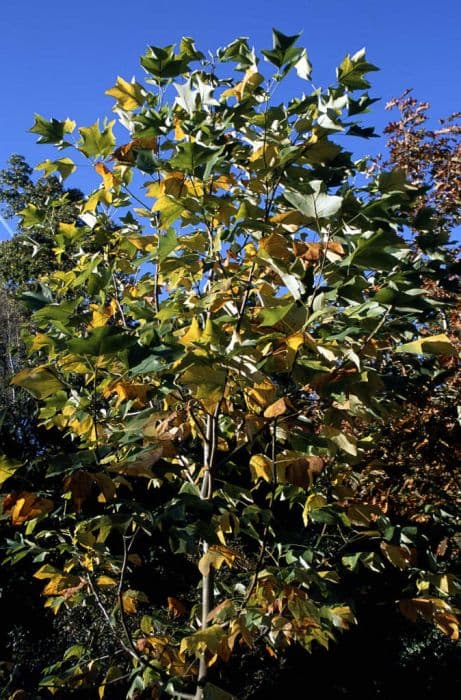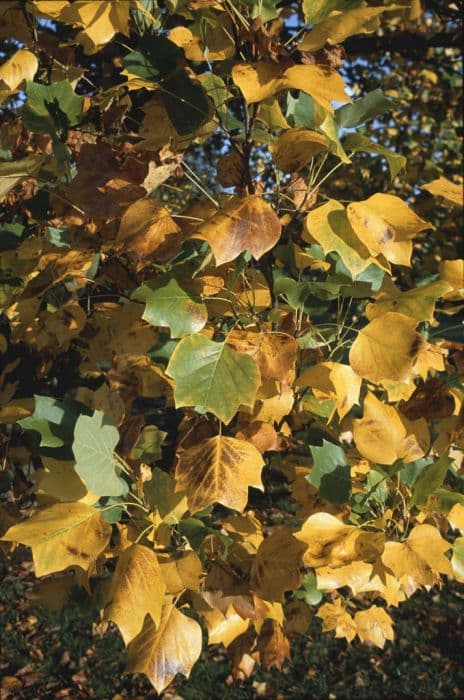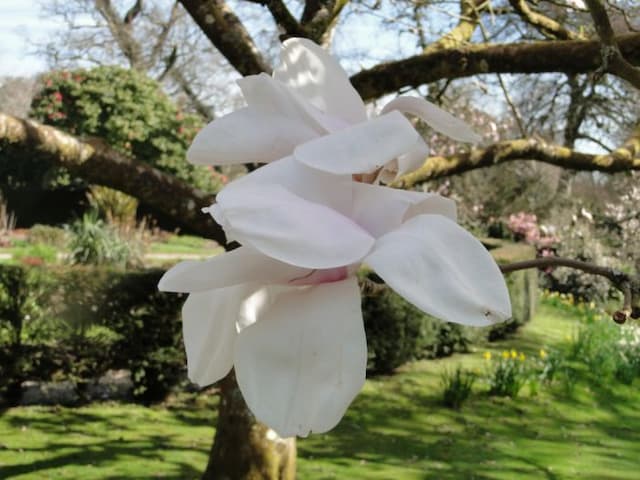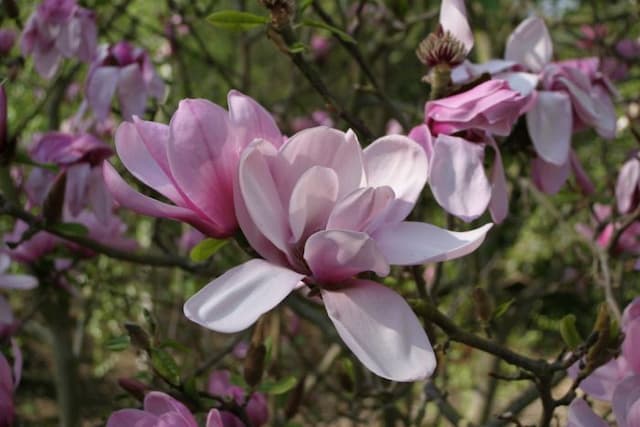Star Magnolia Magnolia stellata 'Royal Star'

ABOUT
The Royal Star is a strikingly beautiful plant known for its showy, star-shaped blooms. This plant is adorned with fragrant flowers that can vary in color from pure white to a delicate pink. Each bloom consists of multiple narrow petals, sometimes numbering more than a dozen, which radiate outwards to create an almost spherical shape when fully opened. The flowers emerge before the foliage in early spring, creating a spectacular floral display that heralds the arrival of warmer weather. The leaves of the Royal Star are also noteworthy. They have a broad, oblong shape with a smooth, shiny surface and a lush, dark green color that provides a striking backdrop to the luminous blossoms. The foliage turns a golden bronze color in the fall, adding seasonal interest to the plant. Overall, the Royal Star is a stunning ornamental plant that exudes elegance and charm with its starry blooms and lush foliage. Its appearance makes it a much-loved addition to gardens where it can be showcased as a specimen plant or used in a grouping for visual impact during its peak blooming season.
About this plant
 Names
NamesFamily
Magnoliaceae
Synonyms
Star Magnolia, Royal Star Magnolia
Common names
Magnolia kobus var. stellata, Magnolia stellata 'Royal Star'
 Toxicity
ToxicityTo humans
Star Magnolia is not commonly known to be toxic to humans. There are no widespread reports of poisoning or severe reactions from ingesting any part of the plant. Therefore, accidental ingestion is unlikely to cause harm, although it is always prudent to avoid eating ornamental plants as a general safety precaution.
To pets
Star Magnolia is also not considered toxic to pets. It's not known to cause serious illness or symptoms of poisoning if pets happen to ingest parts of the plant. However, it's always wise to monitor pets around plants and discourage them from chewing on any non-food plants to prevent any possible gastrointestinal upset or an unexpected allergic reaction.
 Characteristics
CharacteristicsLife cycle
Perennials
Foliage type
Deciduous
Color of leaves
Green
Flower color
White
Height
15-20 feet [4.57-6.1 meters]
Spread
10-15 feet [3.05-4.57 meters]
Plant type
Shrub
Hardiness zones
4-8
Native area
Japan
Benefits
 General Benefits
General Benefits- Ornamental Appeal: Magnolia stellata 'Royal Star' is highly valued for its stunning star-shaped flowers that bloom in early spring, providing a spectacular floral display.
- Compact Size: This cultivar has a compact, multi-stemmed growth habit, making it an ideal choice for smaller gardens or spaces.
- Four Season Interest: Beyond the spring bloom, it offers attractive green foliage in summer, which may turn golden-brown in autumn, and has a pleasing form in winter.
- Drought Tolerance: Once established, it has good drought tolerance, reducing the need for frequent watering.
- Cold Hardy: It is suitable for growing in a range of climates as it is resistant to damage from cold winter temperatures.
- Low Maintenance: Requires minimal pruning and upkeep once it is established, making it a good choice for gardeners seeking a low-maintenance plant.
- Pollinator Attraction: The flowers provide an early season nectar source for bees and other pollinators, which are crucial for the environment.
 Medical Properties
Medical PropertiesThis plant is not used for medical purposes.
 Air-purifying Qualities
Air-purifying QualitiesThis plant is not specifically known for air purifying qualities.
 Other Uses
Other Uses- The petals of Royal Star magnolia can be used to make a delicate and aromatic syrup, often used to add a floral note to cocktails, desserts, or teas.
- Crushed leaves of the Royal Star magnolia may be infused into oils for use in perfumery, offering a mild, sweet scent as a base note.
- When dried, the bark of Royal Star magnolia can be used as a natural brown dye for textiles and crafts.
- The wood from a Royal Star magnolia is sometimes used in small woodworking projects for its fine grain and ease of carving.
- Floral designers use the blooms of Royal Star magnolia as a focus in bridal bouquets and spring arrangements for their soft texture and star-like appearance.
- The tree itself can be grown in a large container to create elegant patio or balcony accents in urban garden settings.
- Putting the flowers in a bowl of water can make a simple and naturally fragrant centerpiece for spring gatherings or thematic events.
- Petals of the Royal Star magnolia can also be used to create natural confetti for celebrations, adding a biodegradable and colorful accent to any event.
- The leaves can be used to create a natural leaf mold compost, which is particularly rich and beneficial for soil health in gardens.
- An extract from the flowers is sometimes used in fragrance diffusers or potpourri mixes to bring a fresh, floral scent to indoor spaces.
Interesting Facts
 Feng Shui
Feng ShuiThe Star Magnolia is not used in Feng Shui practice.
 Zodiac Sign Compitability
Zodiac Sign CompitabilityThe Star Magnolia is not used in astrology practice.
 Plant Symbolism
Plant Symbolism- Purity: The white flowers of the Royal Star Magnolia symbolize purity and dignity, often used to convey an innocent or unblemished quality.
- Persistence: As a plant that can withstand harsh conditions and still bloom beautifully, it represents endurance and tenacity.
- Nobility: Its regal presence and the 'Royal Star' name associate it with noble qualities such as honor and high principles.
- Femininity: The delicate and showy aspects of the blossoms are often connected with grace and feminine qualities.
- Peace: The soothing color and appearance of the flower can symbolize tranquility and peace.
 Water
WaterThe Star Magnolia requires watering to keep the soil consistently moist, especially during the first few years after planting and during the growing season. Generally, water the plant deeply once a week, providing it with about 1 to 1.5 gallons per watering, depending on the size of the plant and weather conditions. Make sure the soil is well-draining to prevent waterlogging. During the winter months, reduce watering as the plant's water requirements decrease.
 Light
LightStar Magnolia thrives in full sun to partial shade. It is best to plant it in a spot where it will receive at least four hours of direct sunlight daily. However, in regions with particularly hot summers, it benefits from some afternoon shade to protect it from the intense heat.
 Temperature
TemperatureStar Magnolia prefers temperate climates and can generally withstand temperatures as low as -20 degrees Fahrenheit, though it ideally should be grown in areas where winter temperatures do not drop below -10 degrees Fahrenheit. The ideal temperature range for optimal growth is between 60 and 70 degrees Fahrenheit during the growing season.
 Pruning
PruningPrune Star Magnolia to shape the plant, remove any dead or damaged branches, and promote good airflow within the canopy. Pruning should usually be done in late winter or early spring before new growth begins. Light pruning can also be done immediately after flowering to maintain the desired shape without affecting next year's blooms.
 Cleaning
CleaningAs needed
 Soil
SoilThe Star Magnolia prefers moist, well-drained, slightly acidic to neutral soil. A good mix can be composed of loamy garden soil, peat moss, and perlite in equal parts, with a pH range of 5.5 to 7.
 Repotting
RepottingStar Magnolia trees, being slow growers, do not need to be repotted often. Generally, repotting once every 3 to 5 years is sufficient to refresh the soil and provide room for growth.
 Humidity & Misting
Humidity & MistingThe Star Magnolia thrives in average outdoor humidity levels and does not require any special humidity conditions when planted outdoors.
 Suitable locations
Suitable locationsIndoor
Place in bright, indirect light and ensure large container.
Outdoor
Plant in well-drained soil, full sun to part shade.
Hardiness zone
4-8 USDA
 Life cycle
Life cycleThe 'Royal Star' Magnolia, a cultivar of Magnolia stellata, begins its life as a seed, which under suitable conditions germinates and develops into a seedling. As the plant grows, it enters the vegetative stage marked by the elongation of the stem and the growth of roots, leaves, and branches. This is followed by the maturation phase, when the plant reaches reproductive maturity and starts to produce its distinctive star-shaped flowers, typically in early spring before the leaves appear. After pollination, which is often aided by insects, the flowers develop into cone-like fruits that release red-coated seeds when mature. The plant then enters a period of dormancy, particularly in cooler climates, where leaf shedding occurs in the fall and growth slows down or stops during the winter. Over the years, the 'Royal Star' Magnolia experiences cycles of growth, flowering, and dormancy, progressively growing larger and more robust with each passing year.
 Propogation
PropogationPropogation time
Spring to Summer
The most popular method for propagating the Magnolia stellata 'Royal Star', commonly known as Star Magnolia, is through softwood cuttings. This technique is usually done in late spring or early summer when the wood is new and yet not fully hardened. Cuttings should be taken from healthy branches, ideally about 4 to 6 inches (10 to 15 cm) long, with several leaves left at the top. The lower leaves are removed, and the cut end dipped in rooting hormone to encourage root development. The cutting is then placed in a well-draining potting mix, ensuring high humidity and indirect light for the cuttings to root effectively. It can take several weeks for the cutting to establish roots, after which it can be transplanted to a more permanent location.









